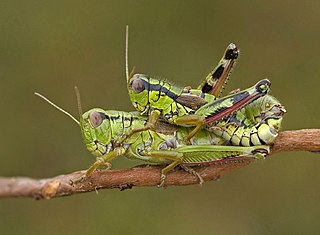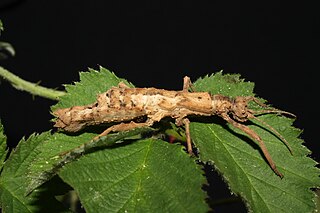
The grasshopper subfamily Acridinae, sometimes called silent slant-faced grasshoppers, belong of the large family Acrididae in the Orthoptera: Caelifera.

The Melanoplinae are a subfamily of grasshoppers in the family Acrididae. They are distributed across the Holarctic and Neotropic ecozones.

The Verophasmatodea suborder of the Phasmatodea contains the vast majority of the extant species of stick and leaf insects.

Acridoidea is a superfamily of grasshoppers in the order Orthoptera with species found on every continent except Antarctica.

Eumastacidae are a family of grasshoppers sometimes known as monkey- or matchstick grasshoppers. They usually have thin legs that are held folded at right angles to the body, sometimes close to the horizontal plane. Many species are wingless and the head is at an angle with the top of the head often jutting above the line of the thorax and abdomen. They have three segmented tarsi and have a short antenna with a knobby organ at the tip. They do not have a prosternal spine or tympanum. Most species are tropical and the diversity is greater in the Old World. They are considered primitive within the Orthoptera and feed on algae, ferns and gymnosperms, the more ancient plant groups.

Eumastacoidea is a superfamily within the order Orthoptera. The family has a mainly tropical distribution. Some of the characters of the members of the superfamily are the lack of an abdominal tympanum, wings if present widen towards the tip, the antennae are short in some groups the hindlegs are spread out laterally at rest. The overall classification based on genitalic characters and the geographic distribution of the groups are as follows:

Conocephalinae is an insect subfamily in the family Tettigoniidae.

Oxyinae is subfamily of grasshoppers in the family Acrididae. Species are distributed throughout Africa and Australasia.

Morgan Hebard was an American entomologist who specialized in orthoptera, with a collection of over 250,000 samples.
The Tanaoceridae are a monotypic insect family in the Tanaoceroidea, which is a superfamily in the suborder Caelifera. They have been called desert long-horned grasshoppers.

The Lentulidae are a family of grasshoppers found in sub-Saharan Africa.
The Ommexechidae are a family of grasshoppers, in the Orthoptera: suborder Caelifera. Species in this family can be found in the Americas.
The Tristiridae are a family of grasshoppers, in the Orthoptera: suborder Caelifera. Species in this family can be found in the Americas.

Podismini is a tribe of "spur-throated grasshoppers" in the family Acrididae. This tribe is unlike others in the subfamily Melanoplinae in that a substantial number of genera occur outside the Americas.

The Heteropterygidae is a family of stick insects belonging to the suborder Verophasmatodea; species can be found in Australasia, East and Southeast Asia.

Tetriginae is a large subfamily of groundhoppers or pygmy grasshoppers. Members of Tetriginae occur on every continent except Antarctica.
Scelimeninae is a subfamily of ground hoppers belonging to the Tetrigidae family of Orthopterans.
Fruhstorferiola is a genus of grasshoppers, subfamily Melanoplinae, tribe Podismini Jacobson, 1905 and subtribe Tonkinacridina Ito, 2015; a majority of species found in Eastern Asia.
Coptotettix is an Asian genus of ground-hoppers in the subfamily Tetriginae.













